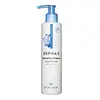What's inside
What's inside
 Key Ingredients
Key Ingredients

No key ingredients
 Benefits
Benefits

 Concerns
Concerns

 Ingredients Side-by-side
Ingredients Side-by-side

Water
Skin ConditioningSodium Methyl Cocoyl Taurate
CleansingCocamidopropyl Hydroxysultaine
CleansingGlyceryl Laurate
EmollientDisodium Laureth Sulfosuccinate
CleansingCocamidopropyl Betaine
CleansingSodium Hyaluronate
HumectantPanthenol
Skin ConditioningTocopheryl Acetate
AntioxidantRetinyl Palmitate
Skin ConditioningCymbopogon Schoenanthus Extract
Skin ConditioningEquisetum Arvense Extract
AstringentCarica Papaya Fruit Extract
Skin ConditioningChamomilla Recutita Flower Extract
MaskingAllantoin
Skin ConditioningPotassium Sorbate
PreservativePhenoxyethanol
PreservativeEthylhexylglycerin
Skin ConditioningParfum
MaskingWater, Sodium Methyl Cocoyl Taurate, Cocamidopropyl Hydroxysultaine, Glyceryl Laurate, Disodium Laureth Sulfosuccinate, Cocamidopropyl Betaine, Sodium Hyaluronate, Panthenol, Tocopheryl Acetate, Retinyl Palmitate, Cymbopogon Schoenanthus Extract, Equisetum Arvense Extract, Carica Papaya Fruit Extract, Chamomilla Recutita Flower Extract, Allantoin, Potassium Sorbate, Phenoxyethanol, Ethylhexylglycerin, Parfum
Water
Skin ConditioningAcrylates Copolymer
Cocamidopropyl Hydroxysultaine
CleansingSodium Cocoyl Isethionate
CleansingXylitylglucoside
HumectantPropanediol
SolventCoco-Glucoside
CleansingAnhydroxylitol
HumectantStearic Acid
Cleansing1,2-Hexanediol
Skin ConditioningXylitol
HumectantPanthenol
Skin ConditioningCoconut Alcohol
EmollientCitric Acid
BufferingPEG-150 Pentaerythrityl Tetrastearate
EmulsifyingStearyl Alcohol
EmollientGlycerin
HumectantSodium Hydroxide
BufferingSodium Chloride
MaskingCaprylhydroxamic Acid
Disodium EDTA
Xanthan Gum
EmulsifyingPotassium Sorbate
PreservativeAvena Sativa Leaf Extract
AstringentWater, Acrylates Copolymer, Cocamidopropyl Hydroxysultaine, Sodium Cocoyl Isethionate, Xylitylglucoside, Propanediol, Coco-Glucoside, Anhydroxylitol, Stearic Acid, 1,2-Hexanediol, Xylitol, Panthenol, Coconut Alcohol, Citric Acid, PEG-150 Pentaerythrityl Tetrastearate, Stearyl Alcohol, Glycerin, Sodium Hydroxide, Sodium Chloride, Caprylhydroxamic Acid, Disodium EDTA, Xanthan Gum, Potassium Sorbate, Avena Sativa Leaf Extract
 Reviews
Reviews

Ingredients Explained
These ingredients are found in both products.
Ingredients higher up in an ingredient list are typically present in a larger amount.
Cocamidopropyl Hydroxysultaine is a synthetic cleansing agent, though it is derived from coconut oil.
It is used to enhance the texture of products by boosting lather and thickening the texture. As a cleanser, Cocamidopropyl Hydroxysultaine is mild.
Panthenol is a common ingredient that helps hydrate and soothe the skin. It is found naturally in our skin and hair.
There are two forms of panthenol: D and L.
D-panthenol is also known as dexpanthenol. Most cosmetics use dexpanthenol or a mixture of D and L-panthenol.
Panthenol is famous due to its ability to go deeper into the skin's layers. Using this ingredient has numerous pros (and no cons):
Like hyaluronic acid, panthenol is a humectant. Humectants are able to bind and hold large amounts of water to keep skin hydrated.
This ingredient works well for wound healing. It works by increasing tissue in the wound and helps close open wounds.
Once oxidized, panthenol converts to pantothenic acid. Panthothenic acid is found in all living cells.
This ingredient is also referred to as pro-vitamin B5.
Learn more about PanthenolPotassium Sorbate is a preservative used to prevent yeast and mold in products. It is commonly found in both cosmetic and food products.
This ingredient comes from potassium salt derived from sorbic acid. Sorbic acid is a natural antibiotic and effective against fungus.
Both potassium sorbate and sorbic acid can be found in baked goods, cheeses, dried meats, dried fruit, ice cream, pickles, wine, yogurt, and more.
You'll often find this ingredient used with other preservatives.
Learn more about Potassium SorbateWater. It's the most common cosmetic ingredient of all. You'll usually see it at the top of ingredient lists, meaning that it makes up the largest part of the product.
So why is it so popular? Water most often acts as a solvent - this means that it helps dissolve other ingredients into the formulation.
You'll also recognize water as that liquid we all need to stay alive. If you see this, drink a glass of water. Stay hydrated!
Learn more about Water